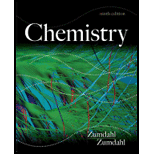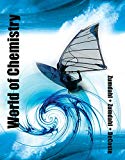
Concept explainers
What is a hydrocarbon? What is the difference between a saturated hydrocarbon and an
The normal (unbranched) hydrocarbons are often referred to as straight-chain hydrocarbons. What does this name refer to? Does it mean that the carbon atoms in a straight-chain hydrocarbon really have a linear arrangement? Explain. In the shorthand notation for cyclic alkanes, the hydrogens are usually omitted. How do you determine the number of hydrogens bonded to each carbon in a ring structure?
Interpretation: The answers of various questions related to hydrocarbons are to be stated.
Concept introduction: The organic compounds containing carbon and hydrogen are known as hydrocarbons. They can be further classified as saturated and unsaturated hydrocarbons. Saturated hydrocarbons contain only single bond between atoms while unsaturated hydrocarbons contains double or triple bonds between the atoms of the molecule.
Answer to Problem 1RQ
Answer
The given questions have been rightfully answered.
Explanation of Solution
Explanation
To explain: The answers of various questions related to hydrocarbons.
Hydrocarbons are the simplest organic compounds.
The organic compounds containing carbon and hydrogen are known as hydrocarbons. They can be straight chain, branched chain or cyclic molecules.
The difference between saturated and unsaturated hydrocarbons is that saturated hydrocarbons contain only single bonds between atoms while unsaturated hydrocarbons contain double or triple bonds between the atoms.
In normal straight-chain hydrocarbons, carbon atoms form long chains while in branched hydrocarbons, hydrogen attached to carbon is substituted by any other group.
When the hydrocarbons contain only single bonds, then they are known as alkanes. The general formula of alkanes is
The hybridization of carbon atom in alkanes is
All the carbon atoms in alkanes are joined by single bonds, thus its hybridization is
In alkanes, each carbon atom forms four bonds and each hydrogen atom forms a single bond with a carbon atom. The bonding around each carbon is tetrahedral, therefore all the bond angles are
The carbon atoms in cyclopropane form an equilateral triangle with a bond angle of
The carbon atoms in cyclobutane form an equilateral square and the bond angle is
Straight chain hydrocarbon does not mean that they have a linear arrangement
The number of hydrogens in cyclic alkanes is calculated by its general formula.
In short hand notation for cyclic alkanes, the hydrogens are usually omitted. They can be determined by the general formula of cyclic alkanes. Their general formula is
For example, in butane, four carbon atoms are present.
The value of
Therefore, the number of hydrogen atoms
Conclusion
Hydrocarbons are simplest organic compounds and the hybridization of carbon atom in alkanes is
Want to see more full solutions like this?
Chapter 22 Solutions
Chemistry
- How does the structure of a cycloalkane differ from that of a straight-chain or branched-chain alkane?arrow_forwardWhy are different conformations of an alkane not considered structural isomers?arrow_forwardDistinguish between isomerism and resonance. Distinguish between structural and geometric isomerism. When writing the various structural isomers, the most difficult task is identifying which are different isomers and which are identical to a previously written structurethat is, which are compounds that differ only by the rotation of a carbon single bond. How do you distinguish between structural isomers and those that are identical? Alkenes and cycloalkanes are structural isomers of each other. Give an example of each using C4H8. Another common feature of alkenes and cycloalkanes is that both have restricted rotation about one or more bonds in the compound, so both can exhibit cis- trans isomerism. What is required for an alkene or cycloalkane to exhibit cis-trans isomerism? Explain the difference between cis and trans isomers. Alcohols and ethers are structural isomers of each other, as are aldehydes and ketones. Give an example of each to illustrate. Which functional group in Table 21-4 can be structural isomers of carboxylic acids? What is optical isomerism? What do you look for to determine whether an organic compound exhibits optical isomerism? 1-Bromo-1-chloroethane is optically active whereas 1-bromo-2-chloroethane is not optically active. Explain.arrow_forward
 ChemistryChemistryISBN:9781305957404Author:Steven S. Zumdahl, Susan A. Zumdahl, Donald J. DeCostePublisher:Cengage Learning
ChemistryChemistryISBN:9781305957404Author:Steven S. Zumdahl, Susan A. Zumdahl, Donald J. DeCostePublisher:Cengage Learning
 Chemistry: An Atoms First ApproachChemistryISBN:9781305079243Author:Steven S. Zumdahl, Susan A. ZumdahlPublisher:Cengage Learning
Chemistry: An Atoms First ApproachChemistryISBN:9781305079243Author:Steven S. Zumdahl, Susan A. ZumdahlPublisher:Cengage Learning Chemistry for Today: General, Organic, and Bioche...ChemistryISBN:9781305960060Author:Spencer L. Seager, Michael R. Slabaugh, Maren S. HansenPublisher:Cengage Learning
Chemistry for Today: General, Organic, and Bioche...ChemistryISBN:9781305960060Author:Spencer L. Seager, Michael R. Slabaugh, Maren S. HansenPublisher:Cengage Learning World of Chemistry, 3rd editionChemistryISBN:9781133109655Author:Steven S. Zumdahl, Susan L. Zumdahl, Donald J. DeCostePublisher:Brooks / Cole / Cengage Learning
World of Chemistry, 3rd editionChemistryISBN:9781133109655Author:Steven S. Zumdahl, Susan L. Zumdahl, Donald J. DeCostePublisher:Brooks / Cole / Cengage Learning





